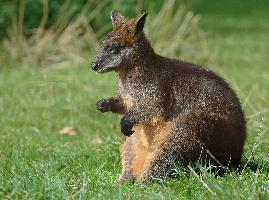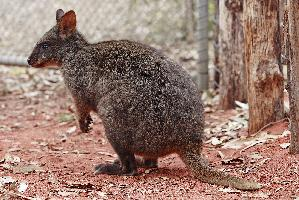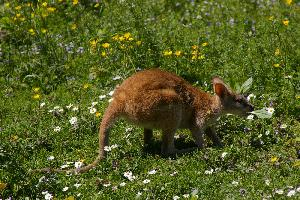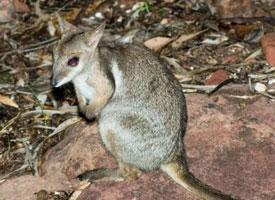
Váhy a míry
| Délka | od 29 do 35 cm |
|---|---|
| Hmotnost | od 1 do 1,7 kg |
| Délka ocasu | od 22 do 31 cm |
Stav ohrožení
| Neohrožen |
Popis zvířete
Nabarleks, scientifically known as Petrogale concinna, are small, yet fascinating marsupials that are part of the rock-wallaby family. These intriguing creatures are primarily found in the rocky and rugged terrains of northern Australia, specifically in areas like the Kimberley region of Western Australia, as well as some parts of the Northern Territory. Their habitat is characterized by steep escarpments and large boulders, providing them with the necessary cover and protection from predators.Nabarleks are relatively small in size compared to other members of the Petrogale genus. They possess a slender build with a body length ranging from 30 to 60 centimeters and a tail that can be just as long, if not longer, than their body. This tail is not prehensile but serves as a vital balance tool when navigating their rocky environment. Their fur is a soft blend of grey and brown, which helps them blend into the rocky surroundings and provides camouflage from predators. The underside is typically a lighter color, ranging from white to a soft cream.
One of the most distinctive features of the Nabarlek is its powerful hind legs, which are adapted for jumping and climbing. These legs allow them to leap between rocks and boulders with agility and precision, an essential skill for escaping predators and foraging for food. Their diet primarily consists of a variety of vegetation, including leaves, grasses, and occasionally fruits, which they find in their rugged habitat.
Nabarleks are nocturnal animals, meaning they are most active during the night. During the day, they seek shelter in caves or crevices among the rocks to rest and avoid the heat. This nocturnal lifestyle helps them conserve water and energy, crucial for survival in their often arid environment.
Breeding for Nabarleks occurs once a year, and like other marsupials, they have a short gestation period. The young, known as joeys, are born extremely undeveloped and crawl into their mother's pouch where they continue to grow and develop over several months. The pouch provides not only protection but also nourishment, as the joeys feed on their mother's milk until they are ready to face the world outside.
Despite their adaptability and agility, Nabarleks face threats from both natural predators, such as birds of prey and snakes, and human-induced challenges. Habitat destruction due to mining and agricultural expansion, along with introduced predators like foxes and feral cats, poses significant risks to their populations. Conservation efforts are underway to protect their habitats and ensure the survival of these unique marsupials.
In summary, Nabarleks (Petrogale concinna) are small, agile marsupials that have mastered the art of living in the rocky terrains of northern Australia. Their nocturnal lifestyle, specialized diet, and remarkable jumping ability make them a unique part of the biodiversity in their region. Despite facing several threats, efforts to conserve their habitat and population are crucial for their continued survival.
Mapa výskytu
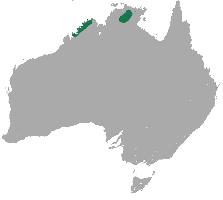
Podobná zvířata
Nové fotografie zvířat
Top 10 zvířat
- Chinese water dragon (Physignathus cocincinus)
- Galápagos tortoise (Geochelone nigra complex)
- Dolphin gull (Leucophaeus scoresbii)
- Japanese macaque (Macaca fuscata)
- Colombian red howler (Alouatta seniculus)
- Sea urchins (Echinoidea)
- Moustached guenon (Cercopithecus cephus)
- Diana monkey (Cercopithecus diana)
- Common reed warbler (Acrocephalus scirpaceus)
- Common house mosquito (Culex pipiens)
